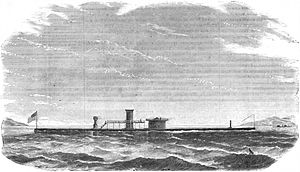Stevens Battery

The Stevens Battery design as of 1874
|
|
| History | |
|---|---|
|
|
|
| Name: | Stevens Battery |
| Namesake: | Its designers and builders, Robert L. Stevens and Edwin Augustus Stevens, who proposed the ship in 1841 |
| Ordered: | By Stevens Battery Act of 1841 |
| Awarded: | 1842 |
| Builder: |
|
| Cost: | Approximately $2,500,000 (USD) spent between 1841 and 1874; approximately $450,000 (USD) additional estimated to be required for launching ship when work ended in 1874 |
| Laid down: | 1854 |
| Launched: | Never |
| Completed: | Never |
| Commissioned: | Never |
| Fate: | Scrapped incomplete 1881 |
| General characteristics (1844 design) | |
| Type: | Semisubmersible ironclad |
| Displacement: | 1,500 tons |
| Length: | 250 ft (76 m) |
| Beam: | 40 ft (12 m) |
| Installed power: | 900 ihp |
| Propulsion: | Steam engine; screw-propelled |
| Speed: | 18 knots (estimated) |
| Armament: | 6 x large muzzle-loading cannons |
| Armor: |
|
| General characteristics (1854 design) | |
| Type: | Semisubmersible ironclad |
| Displacement: | 4,683 tons |
| Length: | 420 ft (130 m) |
| Beam: | 53 ft 0 in (16.15 m) |
| Installed power: | 8,600 ihp |
| Propulsion: | Eight steam engines, two screws, 1,000 tons coal |
| Speed: | 20 knots (estimated) |
| Armament: |
|
| Armor: | 6.75 in (0.171 m) iron plate |
| General characteristics (1869 design) | |
| Type: | Ironclad ram |
| Propulsion: | Ten large-diameter boilers, two Maudsley and Field vertical overhead-crosshead engines, screw-propelled |
| Speed: | 15 knots (estimated) |
| Armament: | never determined |
The Stevens Battery was an early design for a type of ironclad, proposed for use by the United States Navy before the American Civil War. One full-sized example was begun but never completed due to lack of funding.
In 1841, the United States was in the midst of a war scare with the United Kingdom over the American boundary with Canada, among other issues. Americans remembered the British invasion of the United States by sea during the War of 1812 and, to avoid its recurrence, President John Tyler and Secretary of the Navy Abel P. Upshur called for a large increase in the size of the U.S. Navy in order to defend the coast. A like-minded U.S. Congress authorized the use of $8,500,000 (USD) to fund the expansion.
In this environment, Robert L. Stevens and Edwin Augustus Stevens, the sons of Colonel John Stevens of Hoboken, New Jersey, proposed to the Department of the Navy on August 13, 1841 the construction of a revolutionary steam-powered ironclad vessel of high speed, with screw propellers and all machinery below the water line. Congress passed and President Tyler signed the Stevens Battery Act the same year to authorize funding for the construction of the ship, and the U.S. Navy's Board of Commissioners approved the Stevens brothers' specific proposal for the ship in January 1842. An Act of Congress authorizing Upshur to contract for the construction of a shot- and shell-proof steamer, to be built principally of iron, on the Stevens plan was approved on April 14, 1842. The ship, which became known as the "Stevens Battery," was to be the first such ship ever to be built under government authorization. She was intended to serve as a fast, powerful, heavily armored, mobile battery, reinforcing the coastal fortifications of New York City.
...
Wikipedia
